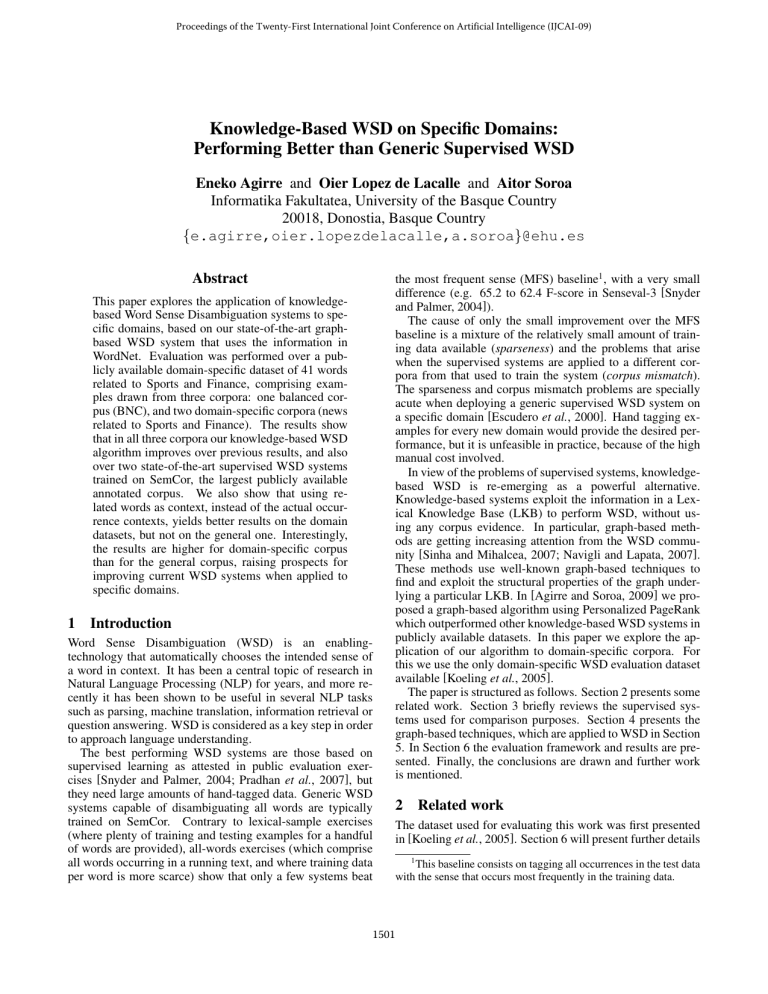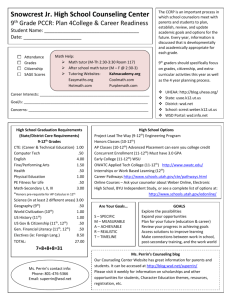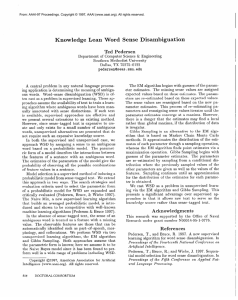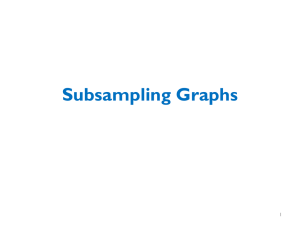Knowledge-Based WSD on Specific Domains: Performing Better than Generic Supervised WSD
advertisement

Proceedings of the Twenty-First International Joint Conference on Artificial Intelligence (IJCAI-09)
Knowledge-Based WSD on Specific Domains:
Performing Better than Generic Supervised WSD
Eneko Agirre and Oier Lopez de Lacalle and Aitor Soroa
Informatika Fakultatea, University of the Basque Country
20018, Donostia, Basque Country
{e.agirre,oier.lopezdelacalle,a.soroa}@ehu.es
Abstract
This paper explores the application of knowledgebased Word Sense Disambiguation systems to specific domains, based on our state-of-the-art graphbased WSD system that uses the information in
WordNet. Evaluation was performed over a publicly available domain-specific dataset of 41 words
related to Sports and Finance, comprising examples drawn from three corpora: one balanced corpus (BNC), and two domain-specific corpora (news
related to Sports and Finance). The results show
that in all three corpora our knowledge-based WSD
algorithm improves over previous results, and also
over two state-of-the-art supervised WSD systems
trained on SemCor, the largest publicly available
annotated corpus. We also show that using related words as context, instead of the actual occurrence contexts, yields better results on the domain
datasets, but not on the general one. Interestingly,
the results are higher for domain-specific corpus
than for the general corpus, raising prospects for
improving current WSD systems when applied to
specific domains.
1
Introduction
Word Sense Disambiguation (WSD) is an enablingtechnology that automatically chooses the intended sense of
a word in context. It has been a central topic of research in
Natural Language Processing (NLP) for years, and more recently it has been shown to be useful in several NLP tasks
such as parsing, machine translation, information retrieval or
question answering. WSD is considered as a key step in order
to approach language understanding.
The best performing WSD systems are those based on
supervised learning as attested in public evaluation exercises [Snyder and Palmer, 2004; Pradhan et al., 2007], but
they need large amounts of hand-tagged data. Generic WSD
systems capable of disambiguating all words are typically
trained on SemCor. Contrary to lexical-sample exercises
(where plenty of training and testing examples for a handful
of words are provided), all-words exercises (which comprise
all words occurring in a running text, and where training data
per word is more scarce) show that only a few systems beat
the most frequent sense (MFS) baseline1 , with a very small
difference (e.g. 65.2 to 62.4 F-score in Senseval-3 [Snyder
and Palmer, 2004]).
The cause of only the small improvement over the MFS
baseline is a mixture of the relatively small amount of training data available (sparseness) and the problems that arise
when the supervised systems are applied to a different corpora from that used to train the system (corpus mismatch).
The sparseness and corpus mismatch problems are specially
acute when deploying a generic supervised WSD system on
a specific domain [Escudero et al., 2000]. Hand tagging examples for every new domain would provide the desired performance, but it is unfeasible in practice, because of the high
manual cost involved.
In view of the problems of supervised systems, knowledgebased WSD is re-emerging as a powerful alternative.
Knowledge-based systems exploit the information in a Lexical Knowledge Base (LKB) to perform WSD, without using any corpus evidence. In particular, graph-based methods are getting increasing attention from the WSD community [Sinha and Mihalcea, 2007; Navigli and Lapata, 2007].
These methods use well-known graph-based techniques to
find and exploit the structural properties of the graph underlying a particular LKB. In [Agirre and Soroa, 2009] we proposed a graph-based algorithm using Personalized PageRank
which outperformed other knowledge-based WSD systems in
publicly available datasets. In this paper we explore the application of our algorithm to domain-specific corpora. For
this we use the only domain-specific WSD evaluation dataset
available [Koeling et al., 2005].
The paper is structured as follows. Section 2 presents some
related work. Section 3 briefly reviews the supervised systems used for comparison purposes. Section 4 presents the
graph-based techniques, which are applied to WSD in Section
5. In Section 6 the evaluation framework and results are presented. Finally, the conclusions are drawn and further work
is mentioned.
2
Related work
The dataset used for evaluating this work was first presented
in [Koeling et al., 2005]. Section 6 will present further details
1
This baseline consists on tagging all occurrences in the test data
with the sense that occurs most frequently in the training data.
1501
on the dataset itself. Koeling et al. used the dataset in order to
evaluate their predominant sense acquisition method, which
consisted basically of two steps. In the first step, a corpus of
untagged text from the target domain was used to construct a
distributional thesaurus of related words. In the second step,
each target word was disambiguated using pairwise similarity
measures based on WordNet, taking as pairs the target word
and each of the most related words according to the distributional thesaurus up to a certain threshold. This method aims
to obtain, for each target word, the sense which is the most
predominant in the target, domain-specific, corpus.
Our work here has a different focus, as our objective is
mainly to compare the performance of state-of-the-art supervised and knowledge-based WSD systems on specific domains, and to study better ways to apply knowledge-based
WSD methods on specific domains. Our proposal can also be
seen as a continuation of [Koeling et al., 2005], and we show
that our WordNet-based WSD method yields better results.
We also study whether the strategy to select one predominant
sense for the whole corpus using the distributional thesaurus
performs better than disambiguating each occurrence of the
word separately.
Graph-based methods using WordNet have recently been
shown to outperform other knowledge-based systems. Sinha
and Mihalcea [2007] use graph-centrality measures over custom built graphs, where the senses of the words in the context
are linked with edges weighted according to several similarity scores. Navigli and Lapata [2007] build a subgraph using
a depth-first strategy over the whole graph of WordNet, and
then apply a variety of graph-centrality measures, with degree
yielding the best results. Our method (cf. Section 4) has been
shown to perform better than those methods in [Agirre and
Soroa, 2009]. The system and the data are publicly available
in http://ixa2.si.ehu.es/ukb/.
Portability problems across corpora for supervised WSD
systems have been well documented in a number of papers [Escudero et al., 2000; Chan and Ng, 2007]. This problem of supervised systems underscores the importance of our
results on domain-specific WSD. More recently [Agirre and
Lopez de Lacalle, 2008; 2009] report positive results when
adapting supervised WSD systems, as evaluated in the same
dataset as used here. Our work is complementary to theirs,
and holds promise for potential combinations.
3
Supervised WSD
As baselines, we use two state-of-the-art WSD classifiers,
which use Support Vector Machines (SVM) and k-Nearest
Neighbors (k-NN), respectively. SVM and k-NN systems
have been widely used in public evaluation exercises, and
have attained high ranks in both lexical-sample and all-words
tasks [Snyder and Palmer, 2004; Pradhan et al., 2007].
k-NN is a memory based learning method, where the
neighbors are the k labeled examples most similar to the test
example. The similarity among instances is measured as the
cosine of their featured vectors. The test instance is labeled
with the sense obtaining the maximum sum of the weighted
votes of the k most similar train instances. We set k to 5 based
on previous work [Agirre and Lopez de Lacalle, 2008]. Re-
garding SVM, we used linear kernels, due to the high amount
of learning features. No soft margin (C) was estimated for
any baseline system and the default C was used. We used the
one-versus-all strategy, as implemented in SVM-Light.
In order to train the classifiers, we relied on the usual features used in previous WSD work, including Local Collocations, Syntactic Dependencies and Bag-of-Words features.
Both systems were trained on Semcor [Miller et al., 1993],
the most widely used sense-annotated corpora. Semcor consists of a subset of the Brown Corpus plus the novel The Red
Badge of Courage. It contains a number of texts comprising
about 500,000 words where all content words have been manually tagged with senses from WordNet. In the case where
target word has fewer than 10 instances in SemCor we have
applied the most frequent sense, as customary in all-words
supervised WSD systems. For the 41 words in the evaluation
dataset (cf. Section 6) 8 words had less than 10 training instances. The maximum amount of training instances was 114,
with an average of 37.
4
PageRank and Personalized PageRank
In this Section we will introduce the PageRank and Personalized PageRank algorithms. The PageRank algorithm [Brin
and Page, 1998] is a method for ranking the vertices on a
graph according to their relative structural importance. The
main idea of PageRank is that whenever a link from vi to vj
exists on a graph, a vote from node i to node j is produced,
and hence the rank of node j increases. Besides, the strength
of the vote from i to j also depends on the rank of node i:
the more important node i is, the more strength its votes will
have. Alternatively, PageRank can also be viewed as the result of a random walk process, where the final rank of node
i represents the probability of a random walk over the graph
ending on node i, at a sufficiently large time.
Let G be a graph with N vertices v1 , . . . , vN and di be the
out degree of node i; let M be a N × N transition probability
matrix, where Mji = d1i if a link from i to j exists, and zero
otherwise. Then, the calculation of the PageRank vector PR
over G is equivalent to solving Equation (1).
PR = cM PR + (1 − c)v
(1)
In the equation, v is a N × 1 vector whose elements are N1
and c is the so called damping factor, a scalar value between
0 and 1. The first term of the sum on the equation models the
voting scheme described in the beginning of the section. The
second term represents, loosely speaking, the probability of
a surfer randomly jumping to any node. The damping factor
c models the way in which these two terms are combined at
each step.
The second term on Eq. (1) can also be seen as a smoothing factor that makes any graph fulfill the property of being
aperiodic and irreducible, and thus guarantees that PageRank
calculation converges to a unique stationary distribution.
In the traditional PageRank formulation the vector v is a
stochastic normalized vector whose element values are all N1 ,
thus assigning equal probabilities to all nodes in the graph in
case of random jumps. However, as pointed out by [Haveliwala, 2002], the vector v can be non-uniform and assign
1502
stronger probabilities to certain kinds of nodes, effectively
biasing the resulting PageRank vector to prefer these nodes.
Such a calculation is often called a Personalized PageRank.
For example, if we concentrate all the probability mass on a
unique node i, all random jumps on the walk will return to i
and thus its rank will be high; moreover, the high rank of i
will make all the nodes in its vicinity to also receive a high
rank. Thus, the importance of node i given by the initial distribution of v spreads along the graph on successive iterations
of the algorithm.
PageRank is actually calculated by applying an iterative
algorithm which computes Eq. (1) successively until convergence below a given threshold is achieved, or, more typically,
until a fixed number of iterations are executed. Following
usual practice, we used a damping value of 0.85 and finish
the calculations after 30 iterations. We did not optimize these
parameters.
5
Application to WSD
In this section we will briefly explain how to apply PageRank and Personalized PageRank to knowledge-based WSD,
as introduced in [Agirre and Soroa, 2009].
A Lexical Knowledge Base (LKB) is formed by a set of
concepts and relations among them, plus a dictionary, which
is a list of words (typically, word lemmas) linked to the corresponding concepts (senses) in the LKB. Such a LKB can
be naturally represented as an undirected graph G = (V, E)
where nodes represent LKB concepts (vi ), and each relation between concepts vi and vj is represented by an undirected edge ei,j . The entries in the dictionary are linked to
their corresponding concepts by directed edges. In this work,
we used WordNet 1.7 as the LKB, with all relations supplemented with disambiguated glosses as provided by the Extended WordNet. This setting was optimal in [Agirre and
Soroa, 2009]. The WordNet version follows that of the evaluation dataset (cf. Section 6).
5.1
Static PageRank (PR), no context
If we apply traditional PageRank over the whole WordNet,
we get a context-independent ranking of word senses. All
concepts in WordNet get ranked according to their PageRank
value. Given a target word, it suffices to check which is the
relative ranking of its senses, and the WSD system would
output the one ranking highest. We call this application of
PageRank to WSD Static PageRank, as it does not change
with the context, and we use it as a baseline.
As PageRank over undirected graphs is closely related to
the degree, the Static PageRank returns the most predominant
sense according to the number of relations the senses have.
We think that this is closely related to the Most Frequent
Sense attested in general corpora, as the lexicon builders
would tend to assign more relations to the most predominant
sense. In fact, our results (cf. Section 6.1) show that this is
indeed the case, at least for the English WordNet.
5.2
Personalized PageRank (PPR), using context
Static PageRank is independent of context, but this is not what
we want in a WSD system. Given an input piece of text we
want to disambiguate all content words in the input according
to the relationships among them. For this we can use Personalized PageRank over the whole WordNet graph.
Given an input text, e.g. a sentence, we extract the list
Wi i = 1 . . . m of content words (i.e. nouns, verbs, adjectives and adverbs) which have an entry in the dictionary,
and thus can be related to LKB concepts. Note that monosemous words will be related to just one concept, whereas polysemous words may be attached to several. As a result of
the disambiguation process, every LKB concept receives a
score. Then, for each target word to be disambiguated, we
just choose its associated concept in G with maximum score.
In order to apply Personalized PageRank over the LKB
graph, the context words are first inserted into the graph G
as nodes, and linked with directed edges to their respective
concepts. Then, the Personalized PageRank of the graph G
is computed by concentrating the initial probability mass uniformly over the newly introduced word nodes. As the words
are linked to the concepts by directed edges, they act as source
nodes injecting mass into the concepts they are associated
with, which thus become relevant nodes, and spread their
mass over the LKB graph. Therefore, the resulting Personalized PageRank vector can be seen as a measure of the structural relevance of LKB concepts in the presence of the input
context.
This method has one problem: if one of the target words
has two senses which are related to each other by semantic
relations, those senses would reinforce each other, and could
thus dampen the effect of the other senses in the context. With
this observation in mind we have used a variant where, for
each target word Wi , the initial probability mass is concentrated in the senses of the words surrounding Wi , but not in
the senses of the target word itself, avoiding to bias the initial
score of concepts associated to target word Wi . In [Agirre
and Soroa, 2009] we show that this variant gets the best results.
Given the fact that finding out the predominant sense seems
a powerful option, we decided to try two further variants of
the Personalized PageRank WSD algorithm. Instead of returning a different sense for each occurrence, we also evaluated the results of selecting the sense which is chosen most
frequently by Personalized PageRank for the target word
(PPRank.maxsense variant). Another alternative is to join all
contexts of the target word into a single large context and then
disambiguate the target word using this large context in a single run (PPRank.all-in-one variant).
5.3
Personalized PageRank (PPR), using related
words
Instead of disambiguating the target word using the occurrence context, we could follow [Koeling et al., 2005] and disambiguate the target word using the set of related words as
collected from the target corpus (cf. Section 2). We would
thus annotate all the occurrences of the target word in the test
corpus with the same sense. For instance, in the Sports corpus, instead of disambiguating the word coach using each of
its occurrences as context (e.g. “Has never won a league title as a coach but took Parma to success in Europe ...”), we
would disambiguate coach using its most related words ac-
1503
Systems
Random
SemCor MFS
Static PRank
Supervised SVM
k-NN
Context
PPRank
PPRank.maxsense
PPRank.all-in-one
[Koeling et al., 2005]
Related
words
PPRank
PPRank.th+ctx
Upperbound Test MFS
Baselines
BNC
19.7
∗
34.9 [33.60, 36.20]
∗
36.6 [35.30, 38.00]
∗
38.7 [37.30, 39.90]
42.8 [41.30, 44.10]
43.8 [42.40, 44.90]
∗
39.3 [38.00, 40.60]
∗
39.6 [38.20, 40.90]
∗
40.7 [39.20, 42.00]
∗
37.7 [36.30, 39.00]
∗
38.2 [36.70, 39.50]
∗
52.0 [50.60, 53.30]
∗
Sports
19.2
∗
19.6 [18.40, 20.70]
∗
20.1 [18.90, 21.30]
∗
25.3 [24.00, 26.30]
∗
30.3 [29.00, 31.20]
∗
35.6 [34.30, 37.00]
∗
36.0 [34.70, 37.40]
∗
42.5 [41.20, 43.90]
∗
43.3 [42.00, 44.60]
51.5 [50.00, 52.90]
49.9 [48.50, 51.60]
∗
77.8 [76.60, 79.00]
∗
Finances
19.5
∗
37.1 [35.70, 38.00]
∗
39.6 [38.40, 41.00]
∗
38.7 [37.10, 40.10]
∗
43.4 [42.00, 44.80]
∗
46.9 [45.39, 48.10]
∗
53.1 [51.70, 54.40]
∗
46.4 [44.90, 47.80]
∗
49.7 [48.00, 51.10]
59.3 [57.80, 60.70]
57.8 [56.40, 59.20]
∗
82.3 [81.00, 83.30]
∗
Table 1: Recall of baselines and systems on each of the corpus (Sports, Finances and BNC), including confidence intervals. ∗
means statistically significant compared to the best system in each column (in bold). Context rows correspond to Personalized
PageRank using occurrence context (cf. Section 5.2). Related words rows correspond to systems using related words as context
(cf. Section 5.3).
cording to the distributional thesaurus (e.g. manager, captain,
player, team, striker, ...). In this work we use the distributional
thesauri built by Koeling et al. [2005], one for each corpus of
the evaluation dataset, i.e. Sports, Finances and BNC. Given a
target noun w, Koeling et al. obtained a set of co-occurrence
triples < w, r, x > and associated frequencies, where r is
a grammatical relation and x the co-occurring word in that
relation. For every pair of nouns, they computed their distributional similarity comparing their respective triples using
the measure suggested by Lin [1998]. Finally, the 50 most
similar nouns are retrieved for each target noun.
6
Evaluation Framework and results
We used the evaluation dataset published in [Koeling et al.,
2005]. This dataset consists of examples retrieved from the
Sports and Finance sections of the Reuters corpus, and also
from the balanced British National Corpus (BNC). 41 words
related to the Sports and Finance domains were selected, according to the following criteria: 18 words having at least
one synset labeled as Sports or Finances according to WordNet Domains, 8 words which had salient frequencies in each
domain (according to the normalized document frequency),
and 7 words with equal salience in both domains. The selected words are quite polysemous and thus difficult to disambiguate, with an average polysemy of 6.7 senses, ranging
from 2 to 13 senses.
Around 100 examples for each word and each of the three
corpora where annotated by three reviewers with senses from
WordNet v. 1.7.1, yielding an inter-tagger agreement of 65%.
Koeling et al. [2005] did not clarify the method to select the
“correct” sense, and we decided to choose the sense chosen
by the majority of taggers. In case of ties we discarded the
occurrence from the test set. This, and the fact that Koeling et al. discarded one of the target words, cause the small
difference (0.2 at most) between the results reported in their
[Koeling et al., 2005] paper, and the ones we quote for them
in Table 1.
6.1
Experimental results
As evaluation measure we use recall, the number of correct occurrences divided by the total number of occurrences.
Recall is more informative than accuracy, as some methods
failed to return results for a handful of occurrences (1% of
occurrences in the worst case). Table 1 shows the results of
the different WSD approaches on the different corpora (expressed in three main columns). The confidence interval is
also shown, as computed using bootstrap resampling with
95% confidence. The systems in the table are divided in four
groups of rows as follows.
The first rows report the baseline approaches, such as the
random baseline, the most frequent sense as attested in SemCor and the results of the static PageRank. In the second
group of rows, the results for supervised systems, k-NN and
SVM, are shown. The next three rows report the variants
for Personalized PageRank over occurrence context (cf. Section 5.2), followed by a further group with results for the
approaches based on related words, including the results of
Koeling et al. and the combination of applying our algorithm
to the related words and each context (th+ctx). Finally, we
show the most frequent sense according to the test data. We
will now consider several issues in turn.
Baselines and supervised systems: The results show that
SemCor MFS is very low, close to the random baseline and
far from the Test MFS, especially for the domain-specific
corpora but also on the general BNC corpus. Note that the
most frequent sense in the test data may be considered as
a kind of “upperbound”, because our systems don’t rely on
hand-tagged data from the domain. The supervised systems
scarcely improve over the Semcor MFS, which is consistent
with state-of-the-art results over all-words datasets [Snyder
and Palmer, 2004; Pradhan et al., 2007]. They also lie well
below the Test MFS, with a dramatic gap in the two domain
corpora. The low results on the BNC show that the deployment of supervised systems is problematic, not only because
of domain shifts, but also because of being applied to different corpora, even being both from the general domain.
1504
Systems
Semcor MFS
k-NN
Context PPR
Related PPR
BNC
54.7
57.1
50.0
38.1
Similar
Sp.
65.5
64.6
34.9
53.1
Different
Sp.
9.7
3.8
24.6 18.5
36.0 35.9
24.8 50.9
Fin.
79.0
69.9
64.2
73.7
BNC
Fin.
8.4
25.4
35.0
49.5
Table 2: Results for those words with similar (and different) sense distributions. Best results in bold.
50
45
40
accuracy
Static PageRank: Applying PageRank over the entire
WordNet graph yields low results, very similar to those of
SemCor MFS, and below those of all Personalized PageRank
variants that we tried. In fact, Static PageRank seems to be
closely related to the SemCor MFS, as we hypothesized in
Section 5.1.
Personalized PageRank over context words: Surprisingly, applying our Personalized PageRank method for each
occurrence yields results which are above the supervised systems in all three corpora, with larger improvements for the
domain-specific ones. The results of the strategies for selecting one single sense as output (maxsense or all-in-one) are
mixed, with slight improvements in Sports and Finances and
degradation in the BNC.
Personalized PageRank over related words: Personalized PageRank over related words obtains the best results
overall for Sports and Finances, and it is thus a preferred strategy to disambiguate domain-specific words. In the case of the
balanced BNC corpus, the best results are for Personalized
PageRank over the occurrence context. It seems that using
related words is optimal for domain-specific WSD, but not
for general purpose WSD, where a more personalized caseby-case treatment is required for each occurrence. Finally,
the combination of the occurrence context and related words
does not seem to be productive, as attested by its decrease in
performance.
Comparison to [Koeling et al., 2005]: Our Personalized PageRank algorithm over related words performs significantly better than [Koeling et al., 2005] in both Sports
and Finances. Our WSD method is closely related to the
WordNet-based similarity method defined in [Hughes and
Ramage, 2007]. In this sense, our WSD algorithm is an alternative to the one used in [Koeling et al., 2005]. Instead of
computing pairwise similarity and selecting the sense which
yields the maximum additive similarity score with respect to
each related word from the distributional thesaurus, our WSD
method implicitly yields the sense with the maximum similarity score with respect to the full set of related words in one
go. In fact, we initialize PPR with all the related words in the
thesaurus, yielding the sense of the target word with the highest rank, i.e. the sense which is most closely related to those
words. Our better results are consistent with the word similarity results reported in [Hughes and Ramage, 2007], which
surpass other WordNet-based similarity methods, including
those used by [Koeling et al., 2005].
Results for coarse-grained senses: WordNet senses have
been criticized for their fine-grainedness. Public evaluation
exercises have also used coarse-grained senses as defined by
the semantic files of the senses. In our case, the best re-
35
30
25
20
StaticPR
10
20
30
40
50
60
70
number of related words
Figure 1: Learning curves for PPR (Sports) using different
numbers of related words from the distributional thesaurus.
Leftmost point is null context, which equals to static PR.
sults for BNC, Sports and Finances measured according to
coarse senses would be of 56.9%, 61.2% and 72.0%, respectively. This is remarkable given the high polisemy of the target words. The overall results for Sports and Finances are
higher than for BNC, holding promise for building effective
domain-specific WSD in specific domains.
Effect of sense distributions: The performance of the supervised systems could be affected by the very different distribution of word senses in the training (Semcor) and test
dataset (all three corpora), as attested by the very low performance of the Semcor MFS and the dramatic difference
with respect to the Test MFS. We decided to make two
groups of words for each corpus, according to the similarity of sense distributions measured as the difference between
Semcor MFS and Test MFS. In the Similar distribution group
we included those words with differences below 10 percentage points, and in the Different distribution group those with
larger differences. Note that for each domain we acquire different set words: for Sports we had 12 Similar words and 29
Different words, for Finances we had 16 and 25, and for the
BNC 19 and 22, respectively. Table 2 shows that for Similar sense distributions the best results are actually those of
the Semcor MFS and the supervised WSD system, while the
Personalized PageRank algorithms yield the best results for
Different sense distributions.
Exploring the number of related words: Following
[Koeling et al., 2005] we used the 50 most similar words
when doing WSD. Figure 1 shows that the number of words is
an important factor, with best results for 30-50 words. These
1505
results agree with the intuition that a minimum amount of
words is necessary for providing context, but introducing further terms down the list of related words involves noisier and
less related words.
7
Conclusions and future work
This paper shows that, when tagging domain-specific corpora, Knowledge-Based WSD systems are a powerful alternative to generic supervised WSD systems trained on balanced corpora.
The results range from 51.5% to 59.3% (61.2% to 72%
coarse-grained) for 41 domain-related and highly polysemous
words. The results are higher for domain-specific corpus than
for the general corpus, raising interesting prospects for improving current WSD systems when applied to specific domains.
The results also show that our knowledge-based WSD algorithm improves significantly over previous results on the
same dataset. The system and the data are publicly available
in http://ixa2.si.ehu.es/ukb/. Disambiguating
related words from a distributional thesauri (instead of the actual occurrence contexts) yields better results on the domain
datasets, but not on the general one.
Our analysis showed that the differences in sense distribution hurt supervised systems, and a combination of supervised
and knowledge-based systems which takes this into account
seems promising. In particular, our approach is complementary to supervised domain-adaptation techniques [Agirre and
Lopez de Lacalle, 2008; 2009]. Given the existing difference
with respect to the Test MFS, there is ample room for further
improvements.
The dataset we used is a lexical-sample, and our results
might depend on the actual words in the sample. For the
future, we would like to confirm our findings on an allwords domain-specific corpus, such as the one planned for
SemEval-2010.
Acknowledgements
Our thanks to Rob Koeling and Diana McCarthy for kindly
providing the dataset, thesauri and assistance. Oier enjoys a
grant from the Basque Government. This work has been partially funded by the EU Commission (FP7 project KYOTO)
and Spanish Research Department (project KNOW).
References
[Agirre and Lopez de Lacalle, 2008] E. Agirre and O. Lopez
de Lacalle. On robustness and domain adaptation using
SVD for word sense disambiguation. In Proceedings of the
22nd International Conference on Computational Linguistics (Coling 2008), pages 17–24, Manchester, UK, August
2008.
[Agirre and Lopez de Lacalle, 2009] E. Agirre and O. Lopez
de Lacalle. Supervised domain adaption for wsd. In Proceedings of EACL-09, Athens, Greece, 2009.
[Agirre and Soroa, 2009] E. Agirre and A. Soroa. Personalizing pagerank for word sense disambiguation. In Proceedings of EACL-09, Athens, Greece, 2009.
[Brin and Page, 1998] S. Brin and L. Page. The anatomy of
a large-scale hypertextual web search engine. Computer
Networks and ISDN Systems, 30(1-7), 1998.
[Chan and Ng, 2007] Y. S. Chan and H. T. Ng. Domain adaptation with active learning for word sense disambiguation.
In Proceedings of the 45th Annual Meeting of the Association of Computational Linguistics, pages 49–56, Prague,
Czech Republic, June 2007.
[Escudero et al., 2000] G. Escudero, L. Márquez, and
G. Rigau. An Empirical Study of the Domain Dependence of Supervised Word Sense Didanbiguation Systems.
Proceedings of the joint SIGDAT Conference on Empirical
Methods in Natural Language Processing and Very Large
Corpora, EMNLP/VLC, 2000.
[Haveliwala, 2002] T. H. Haveliwala. Topic-sensitive pagerank. In WWW ’02: Proceedings of the 11th international conference on World Wide Web, pages 517–526,
New York, NY, USA, 2002. ACM.
[Hughes and Ramage, 2007] T. Hughes and D. Ramage.
Lexical semantic relatedness with random graph walks.
In Proceedings of EMNLP-CoNLL-2007, pages 581–589,
2007.
[Koeling et al., 2005] R. Koeling, D. McCarthy, and J. Carroll. Domain-specific sense distributions and predominant
sense acquisition. In Proceedings of the Human Language
Technology Conference and Conference on Empirical
Methods in Natural Language Processing. HLT/EMNLP,
pages 419–426, Ann Arbor, Michigan, 2005.
[Lin, 1998] D. Lin. Automatic retrieval and clustering of
similar words. In Proceedings of the 36th Annual Meeting
of the Association of Computational Linguistics (ACL98)
- joint with Computational Linguistics (Coling98), Montreal, Canada, August 1998.
[Miller et al., 1993] G.A. Miller, C. Leacock, R. Tengi, and
R.Bunker. A Semantic Concordance. In Proceedings of
the ARPA Human Language Technology Workshop. Distributed as Human Language Technology by San Mateo, CA: Morgan Kaufmann Publishers., pages 303–308,
Princeton, NJ, 1993.
[Navigli and Lapata, 2007] R. Navigli and M. Lapata. Graph
connectivity measures for unsupervised word sense disambiguation. In IJCAI, 2007.
[Pradhan et al., 2007] S. Pradhan, E. Loper, D. Dligach, and
M.Palmer. Semeval-2007 task-17: English lexical sample
srl and all words. In Proceedings of SemEval-2007, pages
87–92, Prague, Czech Republic, June 2007.
[Sinha and Mihalcea, 2007] R. Sinha and R. Mihalcea. Unsupervised graph-based word sense disambiguation using
measures of word semantic similarity. In Proceedings of
the IEEE International Conference on Semantic Computing (ICSC 2007), Irvine, CA, USA, 2007.
[Snyder and Palmer, 2004] B. Snyder and M. Palmer. The
English all-words task. In Proceedings of the 3rd ACL
workshop on the Evaluation of Systems for the Semantic
Analysis of Text (SENSEVAL), Barcelona, Spain, 2004.
1506







